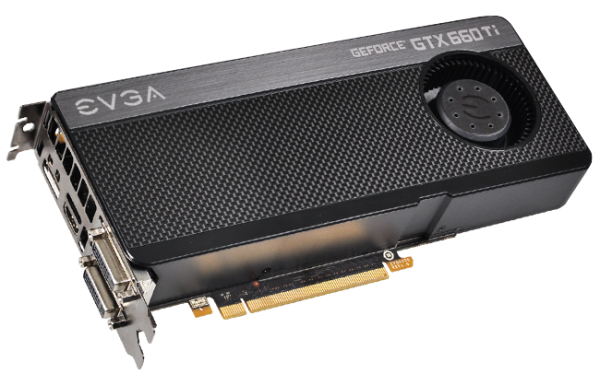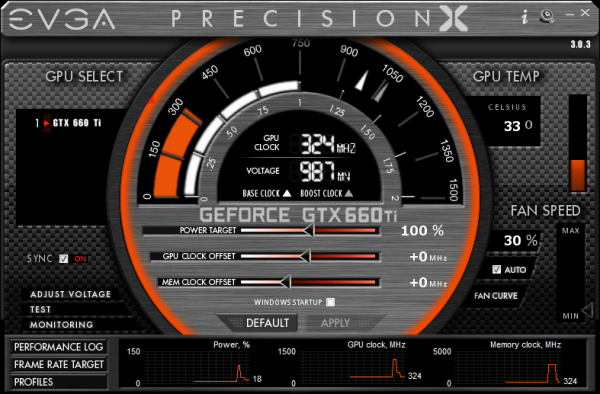The GeForce GTX 660 Ti Review, Feat. EVGA, Zotac, and Gigabyte
by Ryan Smith on August 16, 2012 9:00 AM ESTMeet The EVGA GeForce GTX 660 Ti Superclocked
Our first card of the day is EVGA’s entry, the EVGA GeForce GTX 660 Ti Superclocked. Among all of the GTX 670 cards we’ve looked at and all of the GTX 660 Ti cards we’re going to be looking at, this is the card that is the most like its older sibling. In fact with only a couple cosmetic differences it’s practically identical in construction.
| GeForce GTX 660 Ti Partner Card Specification Comparison | ||||||
| GeForce GTX 660 Ti(Ref) | EVGA GTX 660 Ti Superclocked | Zotac GTX 660 Ti AMP! | Gigabyte GTX 660 Ti OC | |||
| Base Clock | 915MHz | 980MHz | 1033MHz | 1033MHz | ||
| Boost Clock | 980MHz | 1059MHz | 1111MHz | 1111MHz | ||
| Memory Clock | 6008MHz | 6008MHz | 6608MHz | 6008MHz | ||
| Frame Buffer | 2GB | 2GB | 2GB | 2GB | ||
| TDP | 150W | 150W | 150W | ~170W | ||
| Width | Double Slot | Double Slot | Double Slot | Double Slot | ||
| Length | N/A | 9.5" | 7.5" | 10,5" | ||
| Warranty | N/A | 3 Year | 3 Year + Life | 3 Year | ||
| Price Point | $299 | $309 | $329 | $319 | ||
EVGA will be clocking the GTX 660 Ti SC at 980MHz for the base clock and 1059MHz for the boost clock, which represents a 65MHz (7%) and 79MHz (8%) overclock respectively. Meanwhile EVGA has left the memory clocked untouched at 6GHz, the reference memory clockspeed for all of NVIDIA’s GTX 600 parts thus far.
The GTX 660 Ti is otherwise identical to the GTX 670, for all of the benefits that entails. While NVIDIA isn’t shipping a proper reference card for the GTX 660 Ti, they did create a reference design, and this appears to be what it’s based on. Both the EVGA and Zotac cards are using identical PCBs derived from the GTX 670’s PCB, which is not unexpected given the power consumption of the GTX 660 Ti. The only difference we can find on this PCB is that instead of there being solder pads for 16 memory chips there are solder pads for 12, reflecting the fact that the GTX 660 Ti can have at most 12 memory chips attached.
With this PCB design the PCB measures only 6.75” long, with the bulk of the VRM components located at the front of the card rather than the rear. Hynix 2Gb 6GHz memory chips are placed both on the front of the PCB and the back, with 6 on the front and 2 on the rear. The rear chips are directly behind a pair of front chips, reflecting the fact that all 4 of these chips are connected to a single memory controller.
With the effective reuse of the GTX 670 PCB, EVGA is also reusing their GTX 670 cooler. This cooler is a blower, which due to the positioning of the GPU and various electronic components means that the blower fan is off of the PCB entirely by necessity. Instead the blower fan is located behind the card in a piece of enclosed housing. This housing pushes the total length of the card out to 9.5”. Housed inside of the enclosure is a block-style aluminum heatsink with a copper baseplate that is providing cooling for the GPU. Elsewhere, attached to the PCB we’ll see a moderately sized aluminum heatsink clamped down on top of the VRMs towards the front of the card. There is no cooling provided for the GDDR5 RAM.
Elsewhere, at the top of the card we’ll find the 2 PCIe power sockets and 2 SLI connectors. Meanwhile at the front of the card EVGA is using the same I/O port configuration and bracket that we saw with the GTX 670. This means they’re using the NVIDIA standard: 1 DL-DVI-D port, 1 DL-DVI-I port, 1 full size HDMI 1.4 port, and 1 full size DisplayPort 1.2. This also means that the card features EVGA’s high-flow bracket, a bracket with less shielding in order to maximize the amount of air that can be exhausted.
Rounding out the package is EVGA’s typical collection of accessories and knick-knacks. In the box you’ll find a pair of molex power adapters, a quick start guide, and some stickers. The real meat of EVGA’s offering is on their website, where EVGA card owners can download their wonderful video card overclocking utility (Precision X), and their stress test utility (OC Scanner X). The powered-by-RivaTuner Precision X and OC Scanner X still set the gold standard for video card utilities thanks to their functionality and ease of use. Though personally I’m not a fan of the new UI – circular UIs and sliders aren’t particularly easy to read – but it gets the job done.
Next, as with all EVGA cards, the EVGA GeForce GTX 660 Ti Superclocked comes with EVGA’s standard 3 year transferable warranty, with individual 2 or 7 year extensions available for purchase upon registration, which will also unlock access to EVGA’s step-up upgrade program. Finally, the EVGA GeForce GTX 660 Ti Superclocked will be hitting retail with an MSRP of $309, $10 over the MSRP for reference cards.






















313 Comments
View All Comments
PCTC2 - Thursday, August 16, 2012 - link
Pricing for GTX 660 Ti cards will start at $299, continuing NVIDA’s tidy hierarchyNVIDIA, not NVIDA.
PCTC2 - Thursday, August 16, 2012 - link
It's on page 2PCTC2 - Thursday, August 16, 2012 - link
I meant page 1. It's too early in the morning.haukionkannel - Thursday, August 16, 2012 - link
660ti is not bad, 7870 custom cooler version is very tough competitor. I allso would like to see factory overclocked version of AMD card in the same test, but all in all it seems to be close call.Nvidia definitely needs a cart to 200-300$. But it seems to be so that we have to wait untill 700 series for that?
RussianSensation - Thursday, August 16, 2012 - link
Not even. I don't think a 7870 is a competitor since it goes for $250-260 on Newegg. The real competitor is a $320-330 HD7950.MatthiasP - Thursday, August 16, 2012 - link
I don't get why Nvidia keeps ignoring the 200$ market. With economies in Europe and the US going down, i doubt that 300$ cards will be important for the mainstream market. And even there, the 7950 seems to be the better choice.Roland00Address - Thursday, August 16, 2012 - link
They are ignoring that market for they can't make money with it right now. Right now they are facing a shortage of 28nm wafers for TSMC can't produce enough chips right now. They usually make the most money with the $100 to $250 cards for they usually make money on selling high volume cards with low to medium profit.But due to the shortage of 28nm wafers they have decided to only target markets that are low volume and high selling price. Because of this there majority of 28nm wafers are going for the notebook chips they are producing (the 620m to 660m all have 28nm versions). They leftover spare chips they have are going to the gtx680, gtx670, and now gtx660ti which they make a lot of profit on.
Now there is a gt640 on the market right now, but it uses the same die as the 640m le to 660m, so any chips that can't make laptop grade due to not matching the 25w to 50w tdp will be reused in a desktop chip that can be up to 75w tdp where they will be sold at a final street cost of $100. $100 dollars for a 118mm^2 gpu is outrageous considering the 6670 has the same die size but is made on 40nm, outperforms it, uses less energy, and is cheaper.
You won't see a gt640 with gddr5, gt650, or a gtx660 (non ti) until nvidia gets more 28nm wafers. (You also won't see nvidia making 28nm tegras until they get more wafers even if the design for tegra4/wayne was finished right now.) Right now nvidia is a victim of its own success where it is selling every 28nm product it can make, so since it can't make any more 28nm products due to its suppliers and facing a shortage it might as well maximize its profits. $300 to $500 dollar cards maximize profits, Laptop Gpus maximize profits.
CeriseCogburn - Sunday, August 19, 2012 - link
" I don't get why Nvidia keeps ignoring the 200$ market. "560
560Ti
570
460 SLI
560 SE SLI
550Ti SLI
" I do get why amd fans pretend there are no nVidia cards "
TheJian - Monday, August 20, 2012 - link
Not ignoring it. They can't keep up with demand at $300. Your card is coming, but not until they can get more chips (more failed $300 ones?) so they can created a $200 card.Sorry already debunked your 7950 being the better choice. Ignore 2560x1600 and it's not even close. That being said, if you use a 30in monitor, maybe you can argue the 2560x1600, but it's a wash at that level as far as I can see. GTX 660 TI wins many times even in Anandtech's, etc..
thebeastie - Thursday, August 16, 2012 - link
I do almost all my gaming on my Sony HMZ-T1 in the standard 720P resolution, so would be great to see what FPS you get in slightly lower resolutions, especially since this is a card aimed at the lower end of the market.Would be great if you could start doing some 3D FPS benchmarks as well because there is a difference in performance again when you ad 3D rendering to any particular resolution.